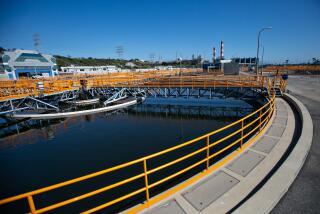Mayor Urges Outside Study of Upgrade to Sewage Plant : Public works: Zukowski says project may be more than Thousand Oaks needs to comply with federal mandates. But others on council disagree with need for independent review.
THOUSAND OAKS — Questioning the need to spend $75 million to expand the city’s sewage treatment plant, Mayor Jaime Zukowski is calling for an independent review of the proposed Hill Canyon plant upgrade.
Zukowski said she fears the city may be doing more than it needs to comply with federal mandates to remove nitrates from fluids discharged by sewage treatment plants. Other area cities have not taken such major steps, she said.
“I’m not saying we shouldn’t do it,” Zukowski said. “I’m just saying we should have all the information before we go forward.”
Her request coincides with a vote scheduled for tonight’s council meeting on raising monthly city sewer rates by nearly 70%--from $10.50 to $17.50 a month.
The rate increase would help fund the $75-million project, which would not only bring the city into compliance with mandates but also provide sewer capacity needed for the city’s growth.
The rate increase requires at least a 4-1 majority vote by the council.
Zukowski’s concerns about the overall project may stall action on the sewer fee increase at tonight’s meeting and are nearly certain to stir heated discussion among council members. Councilwoman Elois Zeanah also has questions about the expense and necessity of the project, but other council members disagree with the mayor.
*
Councilman Mike Markey said a memo that Zukowski sent to the other council members did not sell him on the need for an outside consultant.
“The memo doesn’t say anything,” he said. “I don’t see the rationale in spending more taxpayers’ dollars on this. I’m concerned that we are just going to someone to hear what we want because we didn’t like what we heard before. If you shop long enough you can get an answer you want.”
Although she has requested outside reviews of city staff reports before, Zukowski said it isn’t because she doesn’t trust the staff’s work.
“It’s only common sense that for something of this magnitude that you would get a second opinion from a specialist on regulatory requirements,” Zukowski said.
But Don Nelson, the city’s director of public works, said an outside review is not necessary. “I will have to tell you, I see no value in that,” Nelson said.
Over the past three years, the city has already spent more than $1 million on an outside consultant, environmental engineering giant CH2MHill, Nelson said.
The entire capital improvement project would be spread over 15 years, Nelson said, and plans to upgrade the plant for nitrate removal are not scheduled to start until 2001.
By then, he said, Thousand Oaks and other areas of the arid West may be given relief from compliance with Clean Water Act regulations, which officials say are more appropriate for the rushing waters of the Mississippi than the trickle of Calleguas Creek.
In the meantime, there are other needed improvements at the plant, including $16 million worth of equipment upgrades and seismic improvements, Nelson said.
Of the total $75-million project, $32 million is allocated to expand the capacity of the plant, while only $14 million is related to the compliance issue, he said.
*
Hill Canyon can handle 10.8 million gallons of sewage daily. The proposed expansion would bring that figure up to 14 million gallons--enough to serve a projected population of 136,000 when the city is fully developed.
Zukowski and Zeanah question the need for that capacity given how close the city’s population of 112,000 already is to the projections.
“In 1991, the council raised sewer connection fees and at that time that funding was supposed to pay for an upgrade through 2001,” Zeanah said. “What has happened in four years that suddenly we have a need to fund $75 million in expenses?”
More to Read
Sign up for Essential California
The most important California stories and recommendations in your inbox every morning.
You may occasionally receive promotional content from the Los Angeles Times.










